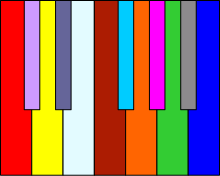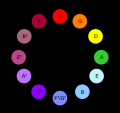Clavier à lumières
The clavier à lumières ("keyboard with lights"), or tastiera per luce, as it appears in the score, was a
Prometheus: Poem of Fire. Only one version of this instrument was constructed, for the performance of Prometheus: Poem of Fire in New York City in 1915.[1] The instrument was supposed to be a keyboard, with notes corresponding to colors as given by Scriabin's synesthetic system, specified in the score.[2] However, numerous synesthesia researchers have cast doubt on the claim that Scriabin was a synesthete.[3][4][5][6]
The "Luce" part is notated on a treble staff with two parts, one proceeding on the
tonal centre of the music.[clarification needed
]
Overview
Scriabin assigned the following colors to the following key areas:[citation needed]

| By chromatic scale | |
|---|---|
| Note | Colour |
| C | red (intense) |
| C♯ | violet or purple |
| D | yellow |
| D♯ | flesh (glint of steel) |
| E | sky blue (moonshine or frost) |
| F | deep red |
| F♯ | bright blue or violet |
| G | orange |
| G♯ | violet or lilac |
| A | green |
| A♯ | rose or steel |
| B | blue or pearly blue |
When the notes are ordered by the

| By spectrum | |
|---|---|
| Colour | Note |
| deep red | F |
| red | C |
| orange | G |
| yellow | D |
| green | A |
| sky blue | E |
| blue | B |
| bright blue | F♯ |
| violet or purple | C♯ |
| lilac | G♯ |
| flesh | D♯ |
| rose | A♯ |
Scriabin was a friend of
Theosophy
, which had its own different system of associating colors and pitches (in essence going up the visible spectrum from C to B chromatically, rather than by fifths).
See also
- Chromesthesia
- Color organ
- Visual music
- Music visualization
- New Epoch Notation Painting
- List of people with synesthesia
References
- ^ Henry Chapin Plummer (10 April 1915). "Colour Music-A New Art Created With the Aid of Science: The Colour Organ Used in Scriabine's Symphony Prometheus" (PDF). Scientific American. Retrieved 11 June 2022. Plummer describes in detail the design and technology used to produce the instrument for the colour effect prescribed by Scriabin.
- ^ Cummings, Robert. "Symphony No. 5 in F sharp major for piano, organ, chorus & orchestra ("Prometheus, Poem of Fire"), Op. 60": "in the score he specifies that certain colors should flood the concert hall during performance".
- ^ ISBN 0-19-263245-0. "In fact, there is considerable doubt about the legitimacy of Scriabin's claim, or rather the claims made on his behalf, as we shall discuss in Chapter 5." (p.31-2)
- ^ S2CID 57564192. "The authors conclude that the nature of Scriabin’s 'color-tonal' analogies was associative, i.e. psychological; accordingly, the existing belief that Scriabin was a distinctive, unique 'synesthete' who really saw the sounds of music—that is, literally had an ability for 'co-sensations'— is placed in doubt."
- ^ ISBN 978-0-262-01279-9.
- ^ ISBN 0-300-06619-8.
- ISBN 9788897523093. "In Europe Skriabin met the painter Jean Delville, who suggested him to study the writings of Castel."
External links
- RhythmicLight.com
- Visual Music A history of Color Organs, various mappings of tones to colors (including Scriabin's), and other representations of music in art.
Further reading
- Alexander Scriabin's Prometheus: Philosophy and Structure by Kenneth John Peacock. 1976 PhD Dissertation at the University of Michigan.

